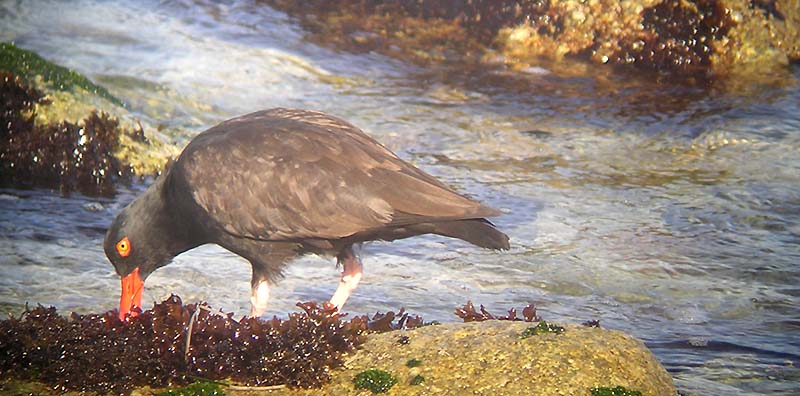

| Black Oystercatcher is a resident along the rocky coastline of Monterey
County from the Monterey Peninsula south down the Big Sur coast to San
Luis Obispo County. They forage in the intertidal zone (above). As they
never leave the habitat, the oystercatchers are usually easy to find although
overall numbers are not large. The Breeding Bird Atlas (Roberson &
Tenney 1193) estimated the MTY population at 77 pairs.
Except for a variable amount of white tipping to belly and flank feathers in fresh basic plumage, Black Oystercatchers show little variation. Fresh basic plumage (right; a Nov photo) is a soft, glossy black. As winter progresses into spring, the back and wings can fade to dark brown (above; a March photo). The white tips on the flank and belly feathers wear and become less noticeable by mid-winter (below, right-hand photo of bowing bird; a January shot). In adults there is a partial molt in Apr-May (extent varies by latitude) and a complete molt July-September (Webster 1942). |
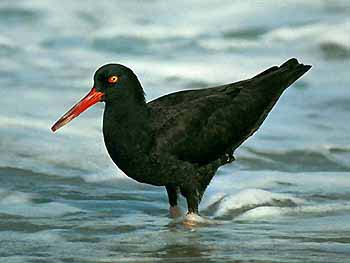 |
|
|
just above: Nov 1979 Pebble Beach © Ronald L. Branson below: upper left 15 Oct 1994 Pt. Pinos © Don Roberson
|
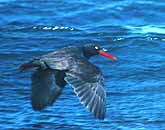
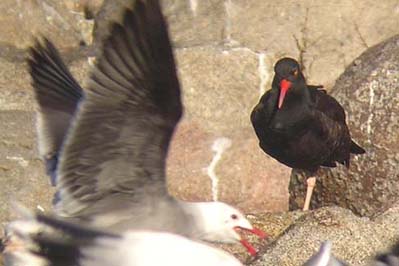 |
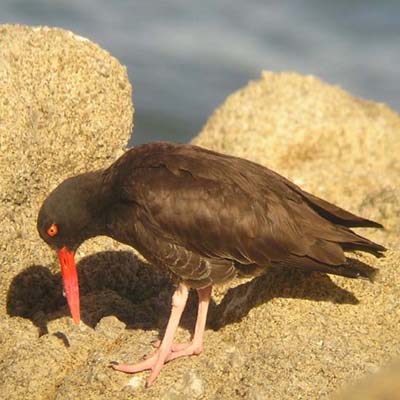 |
| The sexes look essentially alike; I'm only able to confidently sex the individuals in the photo below ; -) [yes, Agnes, the male is on top..... ] |
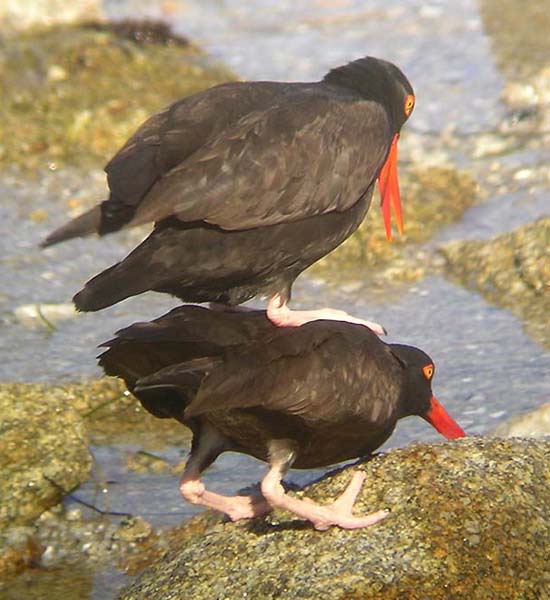 |
| Hayman et al. (1986) state that "females have noticeably longer bills
(average 71.6 mm against 63.2 mm for males)." Youngsters have much shorter
bills than adults, and it takes about two months for the bill to grow to
full length (Webster 1942).
The mating shot (above) was taken 10 March 2004 at Pt. Pinos [© Don Roberson]. Our Atlas data noted eggs by early May and fledglings from mid-June to mid-August. This phenology is consistent with that on the Farallones, where egg-laying is in May, hatching in June-August, and fledglings mid-July to early October (Sowls et al. 1980). Although most of our local oystercatchers seem to maintain territories much of the year, in winter or after storms unusual concentrations can be encountered. My single high count for a roosting group was 19 at Pt. Pinos on 23 Dec 2000. MTY oystercatchers are considered resident, but a banded bird at Pt. Pinos 23 Nov 1975 may have been ringed on the Farallones since no banding was known to have occurred locally. There clearly is some limited movement: a small flock of 12 was seen flying south past the Pajaro R. mouth 6 Oct 2002 (Kumaran Arulanantham) is the only report along the sandy shores of north MTY. |
There has never been an acceptable MTY record of American Oystercatcher.
There are three claims:
|
24 Aug 1977 Corvina Beach, Salton Sea, Riverside Co., CA |
Bibliography:
Part 1: Waterfowl through GrebesReaders may use this material for their own private enjoyment, study, or research but none of the photos or text herein may be used commercially nor may they be reposted on other web sites without written permission. All material is copyrighted. The posting of photos and text on this private web site is not a submission to review organizations.
Part 2: Albatrosses through Frigatebirds
Part 3: Herons through Cranes
Part 4: Plovers through Sandpipers
Part 5: Jaegers through Alcids
Part 6: Doves through Woodpeckers
Part 7: Flycatchers through Larks
Part 8: Swallows through Pipits
Part 9: Waxwings through Warblers
Part 10: Tanagers through Sparrows
Part 11: Grosbeaks through Finches
or just the plain Checklist (no annotations)